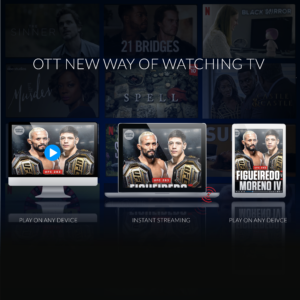In just a few short years, Over-The-Top services have grown from a niche streaming option, to one of the most popular ways to consume media. But what are OTT media services, and how do they work? If you’re like most media consumers in North America, and have a Netflix, Amazon Prime, or Disney+ subscription, you’ve already got some sense of what OTT does – even if you don’t know it.
You probably already know it’s got something to do with the internet, and it’s a way to watch your favorite shows. But how has it become so popular in such a short time, and how can it benefit media businesses?
If you’re looking to gain a better understanding of how OTT services work, why they’ve become so successful, and why more services seem to be popping up all the time, you’ve come to the right place. Here are 4 things you need to know about OTT media services.
1. What Are OTT Media Services?
Over-the-Top media services are online content providers that offer consumers streaming media as a standalone product. The term “OTT media services” often refers to video-on-demand platforms, but may also include services like audio streaming, messaging services, and even internet-based calling solutions.
The defining characteristic of OTT media services is that they sidestep more traditional media distribution channels. Often connected to “cord-cutting,” these services circumvent things like telecommunications networks and cable television providers. Essentially, as long as you have an internet connection, you can access all OTT media services have to offer.
The most common form of monetization for these services is subscriptions. However, some platforms offer in-app purchases or advertising in lieu of subscriptions.
2. How Do OTT Media Services Work?
Most OTT platforms can be accessed through any device with an internet connection. This includes computers, smartphones, tablets, smart TVs, and even gaming consoles. Consumers don’t need a subscription to a TV provider. However, depending on the OTT platform, a subscription to the platform itself may be required. This is how some of the most popular OTT media services, like Netflix and Disney+ operate. On the other hand, others, like Amazon and Peacock, monetized their apps through ads, or offering reduced-cost subscriptions with limited ads.
3. Why is OTT so Popular?
There are several reasons OTT media services have become so wildly popular. To begin with, from the consumer’s point of view, these services are fairly easy to set up and use. As mentioned before, all that is required is an internet connection and an app on an appropriate device. Furthermore, the cost of OTT services remains relatively small compared to traditional television packages. What’s more, cable and satellite TV providers know this, which is why so many are throwing their own hat into the OTT ring.
However, two critical concepts have started to pop up in the minds of consumers when they think about today’s streaming services: fatigue and overabundance. Today’s market is often considered oversaturated with so many platforms to choose from, yet none can fulfill all of any one person’s watching preferences.
That said, the freedom to choose what content to watch, whenever and wherever one chooses is extremely attractive. Additionally, a steady stream of new content with a high production value keeps users engaged.
4. What Are The Advantages of OTT?
Some of the advantages of OTT media services have already been mentioned, but there are several more – from both the consumer’s point of view, and that of businesses.
Consumer Benefits
Content
Traditional pay-TV, like cable or satellite, suffers from somewhat of a lack of content variety. This is due to their limited catalogs or the limitations of content bundles. OTT media services, on the other hand, can offer a wider variety of both licensed and original content, including video-on-demand titles, traditional, linear TV channels, and even live streams.
Price
Thanks to the overall reduced cost of deploying OTT infrastructure, prices also tend to be reduced. Subscriptions can be as low as a few dollars a month, or even free for ad-based services. This frees viewers from “either-or” choices. For less than the cost of cable or satellite TV, viewers can subscribe to a variety of services to meet their content needs. In fact, as of 2021, 75% of Americans are already subscribed to 2 or more OTT services.
Consumer Freedom
With so many options available today, consumers have gotten used to – and love – their ability to choose and control the media they consume. With OTT services, they can now decide exactly what they want to watch, when they will watch it, and what devices they will use. This higher level of consumer choice leads to improved content engagement, and engaged customers stick around longer.
Business Benefits
Simplified Delivery
With OTT media services, content arrives through an open network, without the need for any infrastructure investments or carriage negotiations. In addition, as discussed, users only need a compatible, internet connected device to view content. This all makes OTT services significantly easier to deploy, maintain, and upgrade than traditional media.
Flexible Monetization
As the provider of an OTT service, you have several options for monetization. Depending on your goals and content, subscription-based (SVOD), transaction-based (TVOD), or an ad-based model may be best for maximum user uptake.
Final Thoughts
There’s no denying that OTT media services have exploded over the last few years. Billions of dollars are being invested as you read this, with no signs of slowing any time soon. The fact is, OTT has incredible potential. Video streaming services are on the rise all over the world, with North America representing the most mature market. But Europe and Asia-Pacific are also seeing amazing growth as brands like Netflix, Disney, and HBO spread internationally.
While Over-The-Top services have been around for several years already, they obviously still have plenty of room to grow. The increasing diversity and competition among brands shows that the market is healthy, and will continue to increase in size. Many opportunities are still unexplored, and clever businesses still have time to make their mark.
Clearly, OTT represents a major part of the future of media. With the right developers in your corner you too can tap into this expanding market.







